Factors Affecting Rate of Reaction (GCSE Chemistry)
Factors Affecting Rate of Reaction
Factors Affecting The Rate of Reaction (GCSE Chemistry)
There are five main factors that affect the rate of reaction. These are:
- Temperature
- Concentration of the reactants in solution
- Pressure of the reacting gas
- Surface area of solid reactants
- Catalysts being present
Changing Factors
During a chemical reaction, the five factors mentioned earlier can be changed. They can be increased or decreased, both of which will have an effect on the rate of reaction.
- Rate of reaction can be increased. When temperature, pressure and surface area of reactants are increased, then the rate of reaction will also be increased. Similarly, when the concentration of reactants is increased or a catalyst is present, then the rate of reaction will also be increased.
- Rate of reaction can be decreased. When temperature, pressure and surface area of reactants are decreased, then the rate of reaction will also be decreased. Similarly, when the concentration of reactants is decreased or a catalyst is not present, then the rate of reaction will also be decreased.
Practical to Investigate the Rate of a Reaction
Method 1: Production of a Volume of Gas
- Gas can be captured. Some reactions can give off a gas as the product. In these reactions, we can capture the gas and measure the volume produced.
- A gas syringe can measure the gas. As the gas is formed, a syringe can be used to capture it. The syringe will be connected to the conical reaction flask via a tube and rubber bung.
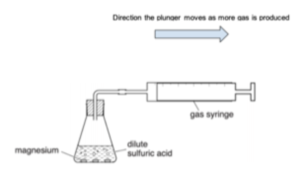
- The volume of gas can be measured. As the reaction progresses, the volume of gas being produced can be measured. The volume shown on the syringe can be recorded at specific time intervals, to the nearest cm3.
- The measurements can be plotted. Using the measurements obtained from the syringe, a graph of gas volumes can be plotted. This can help to determine the rate of reaction.
- This experiment can be dangerous. If a reaction is too vigorous, a lot of gas can be produced in a very short time. The high pressure may cause the plunger to be forced out of the end of the syringe.
Method 2: Change in Colour or Turbidity
- Reactions can be visualised. Through using a colour change, a reaction can be visualised. This visual colour change can allow the rate of reaction to be recorded.
- Equipment must be set up. A piece of card has an ‘X’ drawn onto it. Then, a conical flask is placed on top of the piece of card and filled with a transparent solution, such as hydrochloric acid. The ‘X’ should still be visible.
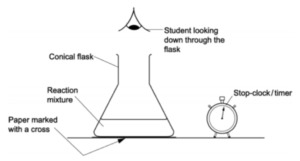
- A reactant is added. A second reactant is added to the conical flask, such as sodium thiosulfate. The product, which is a precipitate of sulphur, will form. As soon as the second reactant is added, the timer must be started.
- The ‘X’ will disappear. As the precipitate forms, the solution will become cloudy. The ‘X’ marked onto the piece of card will begin to disappear. You should time how long it takes for the ‘X’ to completely disappear.
- The experiment is subjective. The results of this experiment are subjective. This is because people might not agree on the point at which the ‘X’ disappears.
- The experiment can be repeated. This experiment can be repeated and the concentration of one of the reactants can be changed. This will allow you to see how changing concentrations can affect the rate of reaction. It is important to keep the volume the same in these reactions.
- Control the variables. If the concentration of one of the reactants is changed, make sure you keep the:
- Concentration and volume of the other reactant the same
- The volume of the reactant whose concentration is changed.
- The initial temperature of the reactant liquids
- The same “X”
Method 3: Change in Mass
- Masses can change. Some experiments will form a gas as one of the products. This gas will be ‘given off’ from the reaction, meaning that there is a decrease of mass at the end of the reaction.
- Mass change can be measured. We can measure the mass of the reactants at the start of the reaction, then the mass of the products at the end. From these measurements, we can calculate how much mass is given off in the form of a gas.
- Rate of reaction can be calculated. If we know how fast the mass decreases, this means we know how fast the gas is released into the surroundings. The faster the release of gas, the faster the rate of reaction.
- A graph can be plotted. From this experiment, we can plot a rate of reaction graph. This can only be done if the mass is recorded at regular intervals throughout the experiment.
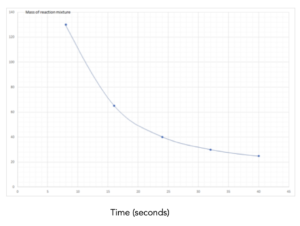
- An example involves dilute HCl and magnesium. We can add dilute hydrochloric acid into a conical flask with a magnesium ribbon. We can prevent the acid from escaping the conical flask by plugging it with cotton wool, as this still allows the gas to escape.
- The experiment can be repeated. This experiment can be repeated and the concentration of acid can be changed. This will allow you to see how changing concentrations can affect the rate of reaction. It is important to keep the volume of acid and the mass of magnesium the same in these reactions.
Changing the Rate of Reaction
We can measure the rate of a reaction between marble chips and hydrochloric acid.

The marble chips of calcium carbonate react with hydrochloric acid to produce calcium chloride solution and carbon dioxide gas. The change in mass due to carbon dioxide escaping is measured against time. This can be plotted on a graph as shown.
The graph becomes less steep as the rate of reaction decreases, due to the reactants being used up.
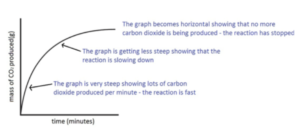
Surface Area
- Changing the surface area of the marble chips affects the rate of the reaction. The shape and size of the marble chips determines the available surface area for the hydrochloric acid to react with.
- Larger marble chips decrease the rate of the reaction. Larger chips have a smaller overall surface area for the hydrochloric acid to react with, which decreases the rate of the reaction.
- The slope of the graph is less steep. The slope is less steep to begin with, showing a slower rate of reaction. It also takes longer to reach a maximum point, which shows that the reaction stops later.
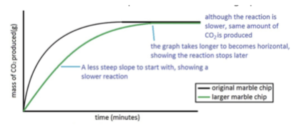
Concentration of Solution
- Changing the concentration of the HCl affects the rate of the reaction. The concentration of the acid determines the number of particles available to react with the marble chips.
- A lower concentration of HCl decreases the rate of the reaction. A lower concentration means there are less reactant particles per unit volume, so a lower chance of the particles colliding. This means there are less successful collisions per second, so a lower rate of reaction.
- The slope of the graph is less steep and reaches a lower maximum. The slope is less steep to begin with, showing a slower rate of reaction. Less product is produced as there are less reactants available.
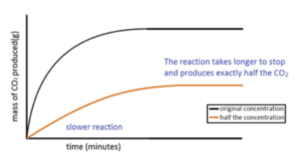
FAQs
The reaction rate is the speed at which a chemical reaction occurs. It is determined by the number of reactant particles that collide and react with each other in a given period of time.
There are several factors affecting the rate of reaction in GCSE chemistry, these includes:
Concentration: Increasing the concentration of the reactants generally increases the rate of the reaction, as there are more particles present in a given volume, which leads to more collisions between the reactant particles and increases the chance of successful collisions.
Surface area: Breaking down a solid reactant into smaller pieces increases its surface area and therefore increases the number of particles exposed to the other reactants, leading to more collisions and increasing the rate of reaction.
Temperature: Increasing the temperature of the reaction generally increases the rate of reaction, as it increases the kinetic energy of the particles, making them move faster and collide more frequently and with more force.
Catalyst: A catalyst is a substance that increases the rate of a reaction without being consumed in the process. It works by providing an alternative pathway for the reaction with a lower activation energy, which makes it easier for the reactant particles to collide and react.
Pressure: Increasing the pressure of a gas reaction can increase the rate of reaction, as it forces the gas particles to occupy a smaller volume, which leads to more frequent collisions between the particles.
The concentration of reactants affects the rate of a reaction because increasing the concentration of reactants will increase the number of reactant particles that are available to collide and react with each other. This results in more successful collisions and a faster rate of reaction.
Temperature affects the rate of a reaction because increasing the temperature will increase the kinetic energy of the reactant particles. This results in more successful collisions between reactant particles and a faster rate of reaction.
Surface area affects the rate of a reaction because increasing the surface area of the reactants will increase the number of available sites for collision. This results in more successful collisions between reactant particles and a faster rate of reaction.
A catalyst affects the rate of a reaction by lowering the activation energy required for the reaction to occur. This means that fewer collisions between reactant particles are needed to reach the energy threshold required for the reaction to occur, resulting in a faster rate of reaction.
Light affects the rate of a reaction because light can provide the energy needed for certain reactions to occur. Light-sensitive substances can absorb light energy and use it to break or form bonds, leading to an increase in the rate of reaction.
The relationship between the rate of reaction and the order of a reaction is that the rate of reaction is proportional to the concentration of reactants raised to a power equal to the order of the reaction. The order of a reaction is the sum of the exponents in the rate law equation and represents the number of molecules of each reactant that are involved in each collision. A higher order of reaction means that more molecules of reactant are involved in each collision, resulting in a faster rate of reaction.





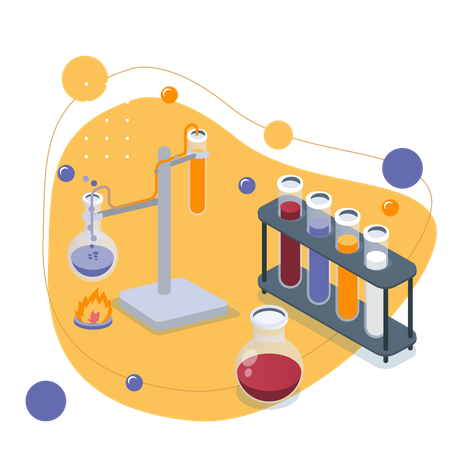
Still got a question? Leave a comment
Leave a comment